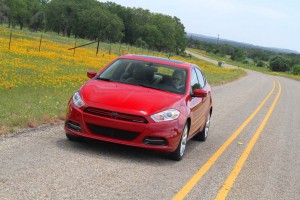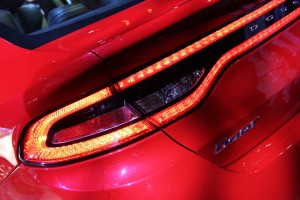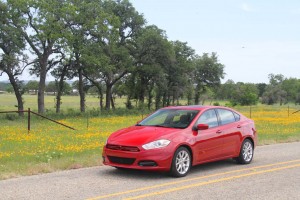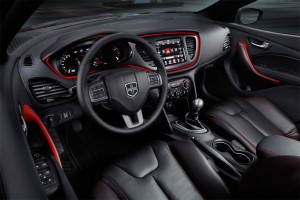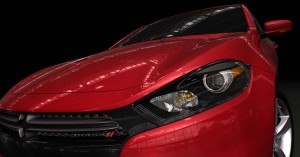With its unexpectedly strong first-quarter earnings it’s no wonder Chrysler officials have been crowing about the turnaround of a company that was bankrupt just three short years ago. Those profits have largely been driven by a surge in demand for models ranging from the midsize 200 sedan to the big Jeep Grand Cherokee. But there’s a gaping hole in the Chrysler corporate line-up that the maker must fill if it hopes to keep that momentum going.
To plug that gap the Dodge division is getting an all-new compact sedan for which the maker curiously decided to revive an old nameplate, the launch of the 2013 Dodge Dart brings back a once-formidable badge last used in 1976.
That means there are perhaps two generations of American motorists who have, at most, vague memories of that nameplate. As for older Baby Boomers, well, the original Dart was popular enough in its heyday but, like so many American models of the 1970s, it had serious issues by the time Dodge dropped it from the line-up. So, gaining traction for an all-new Dart will clearly be a challenge, especially with Dodge aiming at two distinctive audiences: young buyers starting up a family and older empty nesters.
But spending a couple days with several late pre-production models convinced TheDetroitBureau.com that Dodge has nailed the needs of compact customers – enough to pose serious challenges to the segment’s traditional Japanese leaders. That’s especially true when you consider that Dodge will offer five different versions of the new Dart, with six powertrain combinations – including one bumping up to “41-plus” mpg – 14 color and trim packages, three different wheels and 100s of customizable options.
The 2013 Dodge Dart is certainly a welcome replacement for the unloved Caliber, a compact hatchback that seemed both outdated and destined for the rental market as soon as it came to market.
We’ve already seen signs that Chrysler, as a whole, has learned some important lessons from its near-death experience of a few years back. Products like the Jeep Grand Cherokee and big Chrysler 300 sedan feature surprisingly sumptuous interiors that are lightyears beyond the tacky hard plastic cabins the maker was long known – and largely despised – for.
The exterior styling of the new Dodge Dart is far more in tune with the market, as well. While there are many of us who appreciate hatchbacks, the compact segment is still largely comprised of sedan buyers. That said, Dodge stylists have come up with a handsome design featuring the brand’s newly updated double-crosshairs grille, a curvaceous, almost coupe-like roofline and the sort of broad hips and high rear shoulders that fit the muscular image that Dodge likes to portray.
While designers often have a tendency to focus on a car’s “face,” downplaying or even ignoring the tail, that’s not the case here, the 2013 Dart’s rear end being perhaps its most particularly appealing angle. That’s because it lifts the signature look of the Dodge Challenger, wraparound red LEDs here enhancing the width of the new compact sedan.
Making the Dart appear as wide as possible was something both designers and engineers fretted over, especially as the new sedan is the first Chrysler corporate product to share its platform with Italian partner Fiat. In this particular case, that means Dart’s underlying “architecture” has been borrowed from the Alfa Romeo Giulietta.
But in Detroit trim – dubbed the Compact U.S. Wide platform — it’s widened a full two inches, something that enhances both the car’s visual stance and its surprisingly roomy interior – which actually places the 2013 Dodge Dart in the EPA’s midsize category. The good news is that the necessary changes neither compromised the nibble road manners of the Giulietta nor cost Dodge on the mileage front.
While it won’t blow a Challenger off the line, even the Dart with its base 2.0-liter inline-four powertrain delivers reasonable performance. And it’s minus that raspy screech that has traditionally irritated buyers of small American cars. It has a level of refinement welcome from a Detroit I-4.
Dubbed Tigershark, the 16-valve engine delivers 160 horsepower and 148 pound-feet of torque and gets fuel economy rated at 25 mpg City, 36 Highway and 32 Combined, according to the EPA.
For a little more pep, Dodge has the 1.4-liter turbo, making the same 160 hp but 184 lb-ft, something that translates into a bit more oomph off the line. The turbo package, assembled in Michigan, makes extensive use of Fiat’s MultiAir system. In a nutshell, that technology allows for near-infinite adjustments on the fly to the engine’s intake valves to maximize performance while minimizing emissions and fuel consumption. Acceleration is just under 8 seconds 0 to 60, with mileage rated 27/39/32 mpg.
The turbo requires a bit of work to keep the revs in the peak torque band if you want the maximum fun-to-drive factor, but mated with a stick, it was our favorite package.
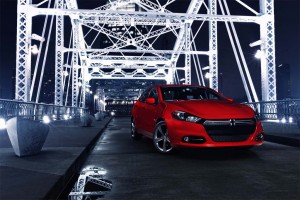
Dodge is offering three different engines in the 2013 Dart and will have out an Aero package topping 41 mpg later this year.
An “Aero” version, featuring extensive body modifications designed to further reduce wind resistance, will come along later this year and bump that highway figure to an impressive “41-plus” mpg, the final figure yet to be determined. That was a critical goal for Chrysler’s Italian partner. As part of the 2009 bailout, Fiat would get an extra 5% stake in its U.S. affiliate by producing a vehicle that topped 40 mpg.
Also TBD is the mileage on the third Dart engine package, a 2.4-liter version of the Tigershark that adopts the MultiAir system to deliver 184 hp and 171 lb-ft.
There are three separate transmission choices, with a 6-speed stick the standard-issue with all engines. The two Tigersharks also offer a choice of a conventional 6-speed automatic, while the 1.4-liter turbo can be fitted with a 6-speed double-clutch gearbox that proved one of the nicest we’ve driven outside the luxury car segment.
Dart features a MacPherson strut-style front suspension with a trailing-arm independent rear axle. If anything, the added width of the Dart only enhances the firmly planted feeling we already knew from the Alfa Giulietta.
Equally impressive: the rack-mounted electric power-assisted steering, which delivered precisely the right amount of boost and great road feel. While we’ve come to accept EPAS technology, it’s rare to find one so well tuned that’s not on a luxury car.
Blasting around Texas Hill Country on a long drive outside Austin we were surprised how much fun a domestic compact can be to drive. The 1.4-liter package, in particular, proved a surprising alternative to what we had hoped for from the disappointing 2012 Honda Civic SE. Even the base Dart puts the aging and wallowing Toyota Corolla to shame.
Mileage has become one of the first things American motorists ask about these days, but technology is another big selling point and the new Dodge Dart has an impressive story to tell there, as well. Among other things, it has finally shifted the cost paradigm on navigation. We’ve long wondered how manufacturers continued charging more than $1,000 for a technology buyers can get ahold of for $100 or so at the local Costco. Sure, there are advantages to having a built-in system, but for that much of a premium it’s no wonder navi has yet to become ubiquitous.
We’re expecting a far higher take rate with Dart, however, where it will be just $495 on mid and upper-level trims already equipped with an 8.4-inch color touchscreen display. For base models, the screen can be added for $595.
Other niceties include Bluetooth, Sirius Satellite with Travel Link, and speech to text capabilities.
On the safety front, the 2013 Dodge Dart more than meets the basic federal requirements – which now include electronic stability control. The sedan also features 10 airbags – more than any compact segment luxury entry, including both the Mercedes-Benz C-Class and Audi A4.
Other high-tech options include rain-sensing wipers, blind-spot monitoring and backup camera.
If there’s a downside to the 2013 Dodge Dart it’s that buyers will need to spend a little time beforehand going through all the various options and packages rather than simply checking one or two boxes at the showroom. Indeed the maker says it’s expecting a significantly larger number of buyers to custom order their Darts rather than simply grabbing whatever is in the lot.
But even a base car, at just $15,995 for the Dart SE, will offer a reasonable amount of content. And the top-rated Limited, at $19,995, promises to deliver one of the best deals in the segment, especially in terms of content for the money.
But content aside, buyers are likely to be quite pleasantly surprised with the underlying attributes of the 2013 Dodge Dart. It’s handsome, well-equipped and a lot of fun to drive. It should change a lot of folks’ minds about what to expect from Detroit and could help shift the balance of power in the compact segment. It won’t send the Japanese packing. They’re too well entrenched. But import buyers who don’t check Dart out if they’re looking for a top-tier compact sedan are simply making a mistake.

